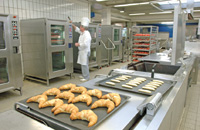
Tricks of the Trade: July 2011
June 22, 2011
By
FORMA-LAB
Choosing the right equipment is daunting. Whether you’re opening a new
bakery or upgrading an old one, it’s a major investment. It’s essential
to do your homework and ask the right questions.
It’s a matter of knowing where your business is now, and where it’s going.
Choosing the right equipment is daunting. Whether you’re opening a new bakery or upgrading an old one, it’s a major investment. It’s essential to do your homework and ask the right questions.
Advice can save you money in the long run, where inexperience can cost you. A good advisor will analyze your needs and help match you to the right supplier to deliver on quality and price. He or she should have a solid background in working with equipment, rather than just playing witness.
The purchase should be examined with these points in mind.
The buying process
A craftsman can start with minimal equipment; it all depends on the experience of the baker. Invest in a good quality mixer and oven, These tools, along with a sturdy work table and reliable scale, are investments in the long-term success of your business. Don’t skimp: these purchases will pay for themselves many times over during the life of your bakery.
 |
|
| Consider the equipment your business needs to succeed now and in the future. |
At minimum you need a working table and a scale. A divider and make-up machine are options that may be good to consider as well.
When looking at the capabilities of new equipment, take the capacity of your existing gear into account. For example, let’s say I make 600 pies per day by hand and I want to buy a pie crust sheeter. There are manual, semiautomatic and automatic sheeters with capacities ranging from 100 to 3,000 pies per hour. When choosing a sheeter, I have to think about my operation’s baking capacity. There’s no gain in purchasing a sheeter that turns out 3,000 pies per hour if your ovens can only bake 600 pies per day.
That’s not to say that you shouldn’t factor in how a piece of equipment may fit into your operation as your business grows. One bakery I consulted for aimed to produce 16,000 baguettes per day. To achieve this, the bakery would have to produce 700 baguettes per hour over three shifts. My first question was: “What do you expect next year?” The owner’s goal was to substantially boost production, increasing output to 30,000 baguettes per day. I pointed out that since he likely will not change equipment after just one year, his estimation of 16,000 baguettes should be made on one shift of labour. That is, his first year production target should be 2,000 baguettes per hour, leaving two other shifts available for expanded production in the future.
As a rule, I consider the real capacity of any piece of equipment to be 80 per cent of the manufacturer’s standards.
Purchasing equipment requires examining current production processes. This is a great time to seek input from your employees. Find out if the current layout of your kitchen and all your equipment is working. Ask if there’s anything that can be done to improve productivity. Minor changes in how the work area is laid out may mean a major boost in your kitchen’s productivity. Ask yourself if you have the power or type of gas required for what you are looking at buying, as well as if the space it takes up would hinder productivity.
Having great equipment is only one part of your bakery’s success. The operator is the one who influences whether a piece of equipment helps or hurts your business. To use equipment effectively, employees must know the machine’s specifications and understand how each piece works.
Plan ahead for big purchases; it can make financing easier. Second-hand equipment may seem like a bargain, but used equipment has a history that may not be immediately apparent. A second-hand machine that requires lots of upkeep can get pricey fast. Like buying a new or a used car, do your homework.
When calculating your budget for new equipment, take a long-term view of the costs associated with operating each piece. It’s easy to overlook sanitation and maintenance costs when budgeting, but these expenses can add up quickly. Choosing one piece over another may save you $1,000 at the time of purchase, but if that machine needs 30 minutes of cleaning per day, the downtime may rapidly eat away at your initial savings.
When budgeting for new gear, keep in mind that any equipment purchase is justified if it pays for itself within the first two years.
Choose your supplier wisely. The best suppliers are those who know their products, speak confidently about them, and answer your questions without merely pushing the sale. When choosing a supplier, ask about after-sales service and any guarantees that may apply.
No matter what you decide to invest in, remember that your equipment is only one ingredient in the formula for your bakery’s success. Buying a $1 million machine will not automatically improve business. Without the right dough and a trained staff willing to learn how to get the most out of the machine, your million-dollar investment can become a million-dollar mistake. Knowing your needs makes it easier to make the right choices for your bakery.
Mario Fortin is an international bakery consultant and owner of FORMA-LAB, a consulting service for bakers and suppliers. If you have a technical problem, send your questions to info@forma-lab.com.
Print this page
Leave a Reply